
北京化工大学2005—2006学年第二学期 《材料导论Ⅱ》期末考试试卷-A 班级: 姓名: 学号: 分数: 题号 三 四 五 六 七 八总分 得分 I.What do the following abbreviations stand for?Translate the abbreviations into Chinese (10pts) 1.BMC 6.MMC 2.CMC 7.PMC 3.DP 8.RTM 4.FRP 9.SMC 5.LCPs 10.TP II.Choose the BEST TERM to match the definition and translate the selected term into Chinese (10pts). A)Ablation L)Nanocomposites B)Adhesion M)Netting index C)Cohesion N)Plasticizers D)Degree of erystallinity )Polymer E)Dielectric constan P Polymerization F)Dielectric strength o)Sealants G)Fiber loading R)Semi-crystalline H)Flame retardants S)Specific strength I)Glass-transition temperature T)Viscoelasticity J)Hysteresis U)Vulcanization K)Monomers V)Whisker 1.Materials used to work like adhesives,provide protective coatings,and keep out liquids and gases. 2.Attraction of molecules between an adhesive and substrate. 3.A human-made,nearly perfect,single crystal with a diameter ranging from about 1 tol0um and lengths up to 3 cm. 4.The ratio of the tensile strength of a fiber material to its weight densityor mass density. 5.The amount of reinforcement inacomposite material 6.The term used to describe the crystallinity of polymers. 7.A property unique to polymers that incorporates two properties of viscosity and elasticity 1而
第 1 页 北京化工大学 2005——2006 学年第二学期 《材料导论 II》期末考试试卷-A 班级: 姓名: 学号: 分数: 题号 一 二 三 四 五 六 七 八 总分 得分 I. What do the following abbreviations stand for? Translate the abbreviations into Chinese (10pts) 1. BMC 2. CMC 3. DP 4. FRP 5. LCPs 6. MMC 7. PMC 8. RTM 9. SMC 10. TP II. Choose the BEST TERM to match the definition and translate the selected term into Chinese (10pts). A) Ablation B) Adhesion C) Cohesion D) Degree of crystallinity E) Dielectric constant F) Dielectric strength G) Fiber loading H) Flame retardants I) Glass-transition temperature J) Hysteresis K) Monomers L) Nanocomposites M) Netting index N) Plasticizers O) Polymer P) Polymerization Q) Sealants R) Semi-crystalline S) Specific strength T) Viscoelasticity U) Vulcanization V) Whisker 1. Materials used to work like adhesives, provide protective coatings, and keep out liquids and gases. 2. Attraction of molecules between an adhesive and substrate. 3. A human-made, nearly perfect, single crystal with a diameter ranging from about 1 to10μm and lengths up to 3 cm. 4. The ratio of the tensile strength of a fiber material to its weight density or mass density. 5. The amount of reinforcement in a composite material. 6. The term used to describe the crystallinity of polymers. 7. A property unique to polymers that incorporates two properties of viscosity and elasticity
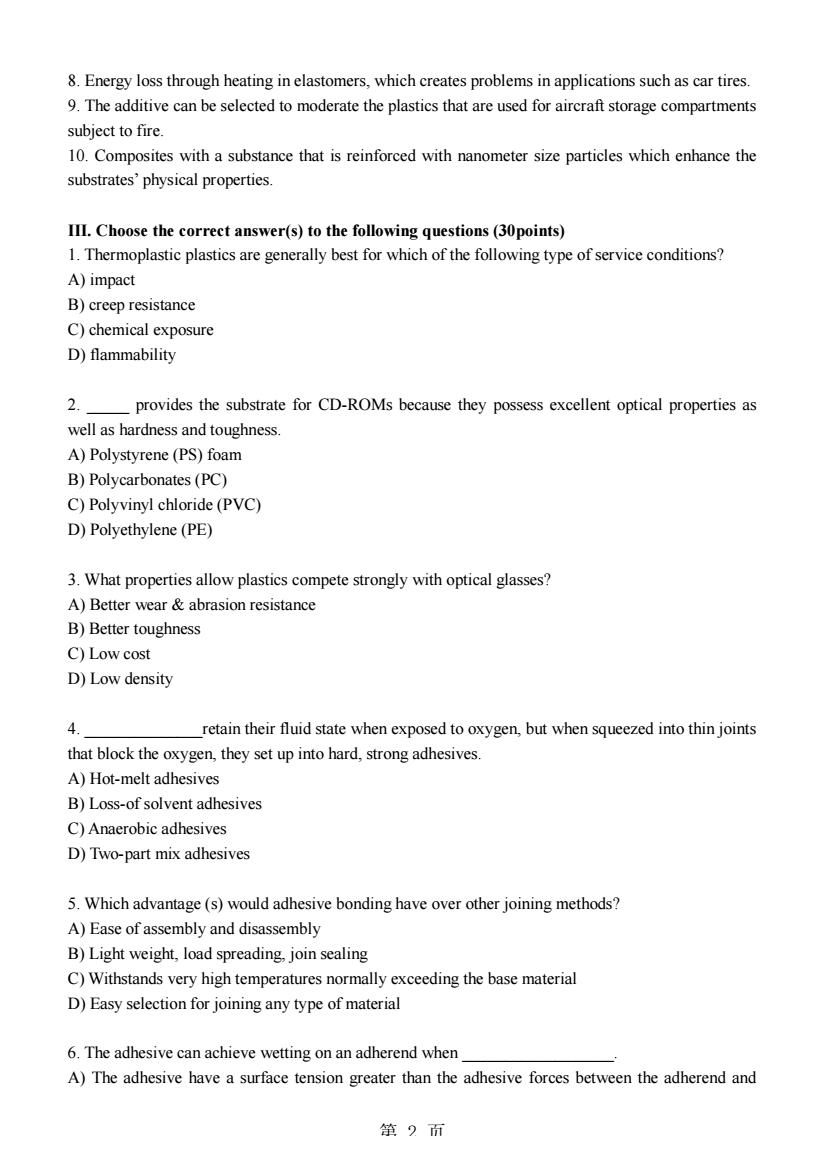
8.Energy loss through heating in elastomers,which creates problems in applications such as car tires. 9.The additive can be selected to moderate the plastics that are used for aircraft storage compartments subject to fire. 10.Composites with a substance that is reinforced with nanometer size particles which enhance the substrates'physical properties. III.Choose the correct answer(s)to the following questions(30points) 1.Thermoplastic plastics are generally best for which of the following type of service conditions? A)impact B)creepresistance C)chemical exposure D)flammability 2 provides the substrate for CD-ROMs because they possess excellent optical properties as well as hardness and toughness. A)Polvstyrene (PS)foam B)Polycarbonates(PC) C)Polvvinvl chloride (PVC) D)Polyethylene(PE) 3.What properties allow plastics compete strongly with optical glasses? A)Better wear abrasion resistance B)Better toughness C)Low cost D)Low density retain their fluid state when exposed to oxygen,but when squeezed into thin joints that block the oxygen,they set up into hard,strong adhesives. A)Hot-melt adhesives B)Loss-of solvent adhesives C)Anaerobic adhesives D)Two-part mix adhesives 5.Which advantage(s)would adhesive bonding have over other joining methods? A)Ease of assembly and disassembly B)Light weight,load spreading.join sealing C)Withstands very high temperatures normally exceeding the base material D)Easy selection for joining any type of material 6.The adhesive can achieve wetting on an adherend when A)The adhesive have a surface tension greater than the adhesive forces between the adherend and 箱9而
第 2 页 8. Energy loss through heating in elastomers, which creates problems in applications such as car tires. 9. The additive can be selected to moderate the plastics that are used for aircraft storage compartments subject to fire. 10. Composites with a substance that is reinforced with nanometer size particles which enhance the substrates’ physical properties. III. Choose the correct answer(s) to the following questions (30points) 1. Thermoplastic plastics are generally best for which of the following type of service conditions? A) impact B) creep resistance C) chemical exposure D) flammability 2. _____ provides the substrate for CD-ROMs because they possess excellent optical properties as well as hardness and toughness. A) Polystyrene (PS) foam B) Polycarbonates (PC) C) Polyvinyl chloride (PVC) D) Polyethylene (PE) 3. What properties allow plastics compete strongly with optical glasses? A) Better wear & abrasion resistance B) Better toughness C) Low cost D) Low density 4. ______________retain their fluid state when exposed to oxygen, but when squeezed into thin joints that block the oxygen, they set up into hard, strong adhesives. A) Hot-melt adhesives B) Loss-of solvent adhesives C) Anaerobic adhesives D) Two-part mix adhesives 5. Which advantage (s) would adhesive bonding have over other joining methods? A) Ease of assembly and disassembly B) Light weight, load spreading, join sealing C) Withstands very high temperatures normally exceeding the base material D) Easy selection for joining any type of material 6. The adhesive can achieve wetting on an adherend when __________________. A) The adhesive have a surface tension greater than the adhesive forces between the adherend and
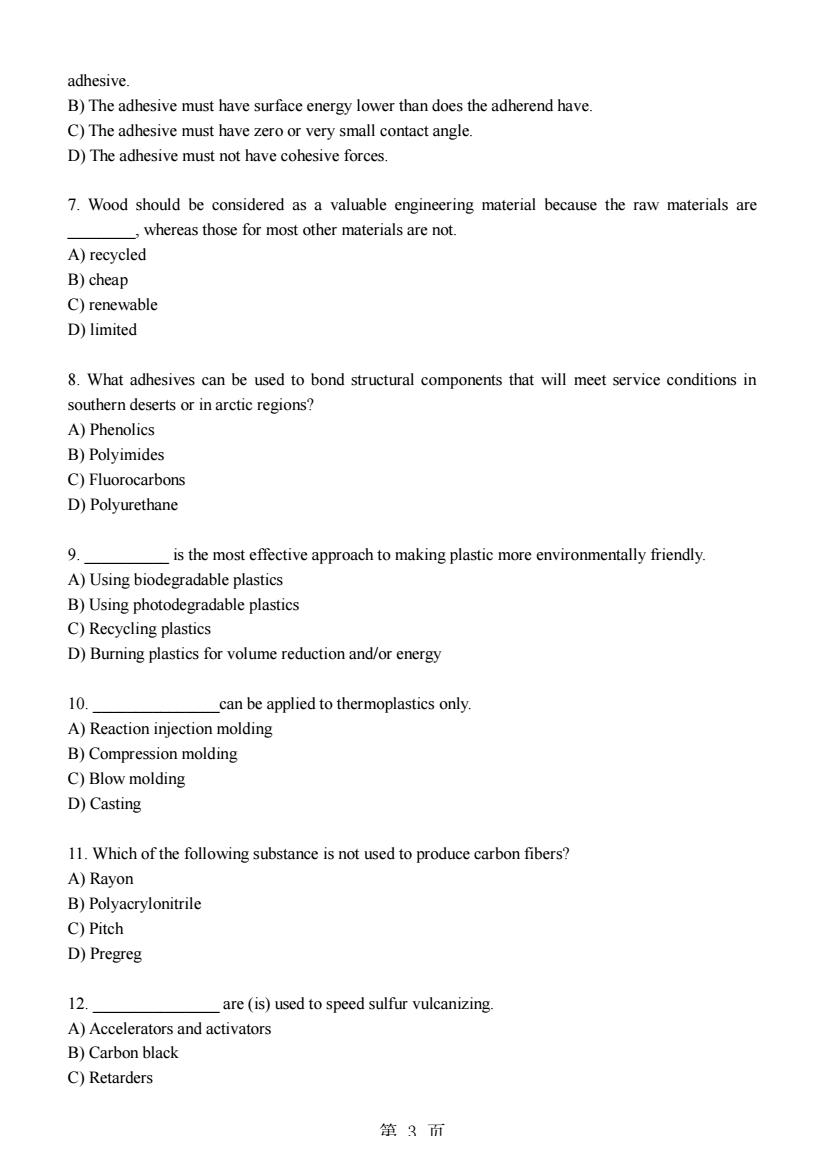
adhesive. B)The adhesive must have surface energy lower than does the adherend have. C)The adhesive must have zero or very small contact angle D)The adhesive must not have cohesive forces. 7.Wood should be considered as a valuable engineering material because the raw materials are whereas those for most other materials are not. A)recycled B)cheap C)renewable D)limited 8.What adhesives can be used to bond structural components that will meet service conditions in southern deserts or in arctic regions? A)Phenolics B)Polyimides C)Fluorocarbons D)Polyurethane 0 is the most effective approach to making plastic more environmentally friendly A)Using biodegradable plastics B)Using photodegradable plastics C)Recycling plastics D)Burning plastics for volume reduction and/or energy 10. can be applied to thermoplastics only A)Reaction injection molding B)Compression molding C)Blow molding D)Casting 11.Which of the following substance is not used to produce carbon fibers? A)Rayon B)Polyacrylonitrile C)Pitch D)Pregreg 12. are(is)used to speed sulfur vulcanizing. A)Accelerators and activators B)Carbon black C)Retarders 第3而
第 3 页 adhesive. B) The adhesive must have surface energy lower than does the adherend have. C) The adhesive must have zero or very small contact angle. D) The adhesive must not have cohesive forces. 7. Wood should be considered as a valuable engineering material because the raw materials are ________, whereas those for most other materials are not. A) recycled B) cheap C) renewable D) limited 8. What adhesives can be used to bond structural components that will meet service conditions in southern deserts or in arctic regions? A) Phenolics B) Polyimides C) Fluorocarbons D) Polyurethane 9. __________ is the most effective approach to making plastic more environmentally friendly. A) Using biodegradable plastics B) Using photodegradable plastics C) Recycling plastics D) Burning plastics for volume reduction and/or energy 10. _______________can be applied to thermoplastics only. A) Reaction injection molding B) Compression molding C) Blow molding D) Casting 11. Which of the following substance is not used to produce carbon fibers? A) Rayon B) Polyacrylonitrile C) Pitch D) Pregreg 12. _______________ are (is) used to speed sulfur vulcanizing. A) Accelerators and activators B) Carbon black C) Retarders
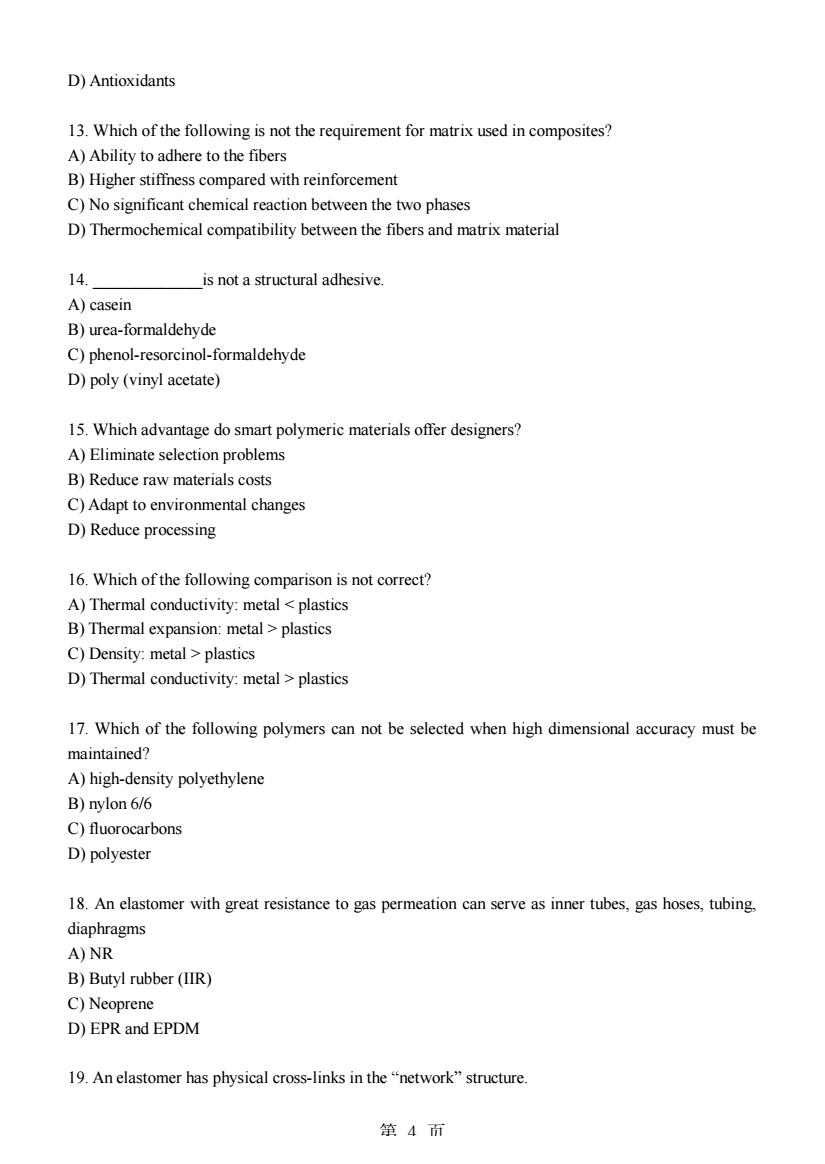
D)Antioxidants 13.Which of the following is not the requirement for matrix used in composites? A)Ability to adhere to the fibers B)Higher stiffness compared with reinforcement C)No significant chemical reaction between the two phases D)Thermochemical compatibility between the fibers and matrix material 14 is not a structural adhesive. A)casein B)urea-formaldehyde C)phenol-resorcinol-formaldehyde D)poly (vinyl acetate) 15.Which advantage do smart polymeric materials offer designers? A)Eliminate selection problems B)Reduce raw materials costs C)Adapt to environmental changes D)Reduce processing 16.Which of the following comparison is not correct? A)Thermal conductivity:metal plastics C)Density:metal plastics D)Thermal conductivity:metal>plastics 17.Which of the following polymers can not be selected when high dimensional accuracy must be maintained? A)high-density polyethylene B)nylon 6/6 C)fluorocarbons D)polyester 18.An elastomer with great resistance to gas permeation can serve as inner tubes,gas hoses,tubing. diaphragms anr B)Butyl rubber(IIR) C)Neoprene D)EPR and EPDM 19.An elastomer has physical cross-links in the"network"structure. 箱4而
第 4 页 D) Antioxidants 13. Which of the following is not the requirement for matrix used in composites? A) Ability to adhere to the fibers B) Higher stiffness compared with reinforcement C) No significant chemical reaction between the two phases D) Thermochemical compatibility between the fibers and matrix material 14. _____________is not a structural adhesive. A) casein B) urea-formaldehyde C) phenol-resorcinol-formaldehyde D) poly (vinyl acetate) 15. Which advantage do smart polymeric materials offer designers? A) Eliminate selection problems B) Reduce raw materials costs C) Adapt to environmental changes D) Reduce processing 16. Which of the following comparison is not correct? A) Thermal conductivity: metal plastics C) Density: metal > plastics D) Thermal conductivity: metal > plastics 17. Which of the following polymers can not be selected when high dimensional accuracy must be maintained? A) high-density polyethylene B) nylon 6/6 C) fluorocarbons D) polyester 18. An elastomer with great resistance to gas permeation can serve as inner tubes, gas hoses, tubing, diaphragms A) NR B) Butyl rubber (IIR) C) Neoprene D) EPR and EPDM 19. An elastomer has physical cross-links in the “network” structure
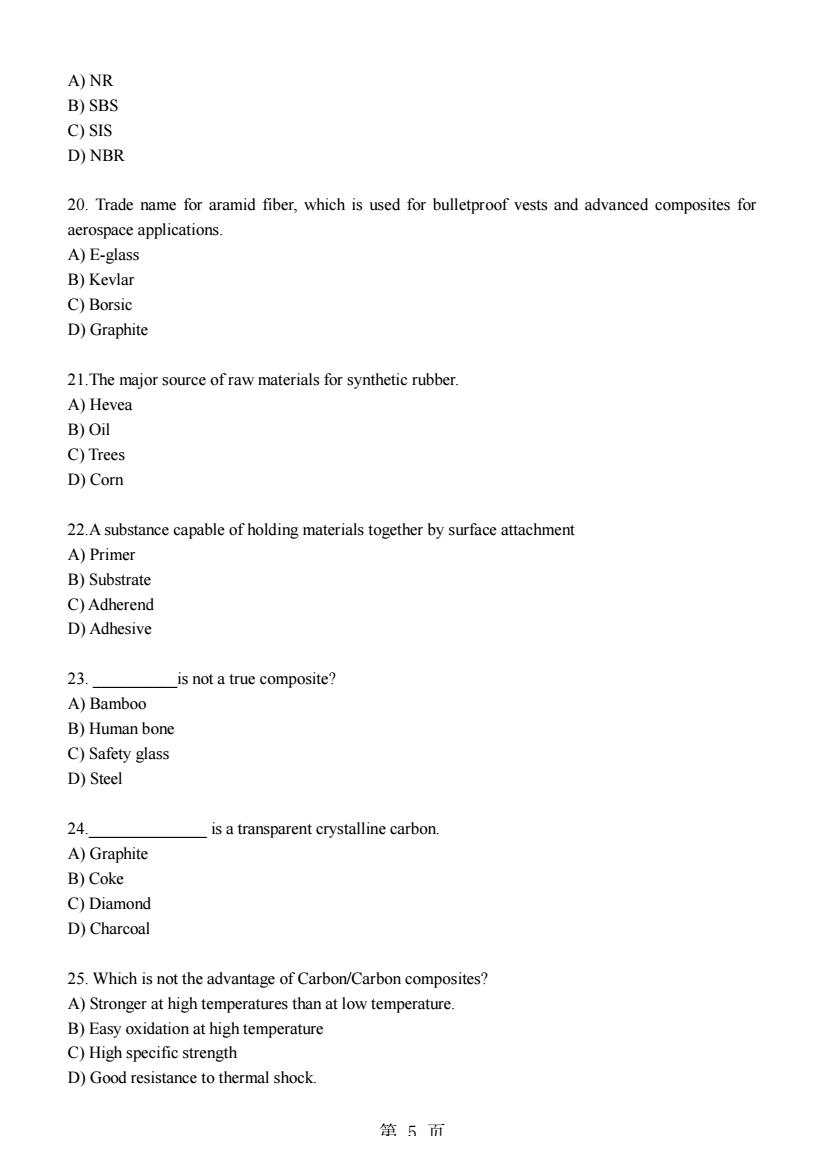
A)NR B)SBS C)SIS D)NBR 20.Trade name for aramid fiber,which is used for bulletproof vests and advanced composites for aerospace applications A)E-glass B)Kevlar C)Borsic D)Graphite 21.The major source ofraw materials for synthetic rubber. A)Hevea B)Oil C)Trees D)Corn 22.A substance capable of holding materials together by surface attachment A)Primer B)Substrate C)Adherend D)Adhesive 23. is not a true composite? A)Bamboo B)Human bone C)Safety glass D)Steel 24. is a transparent crystalline carbon. A)Graphite B)Coke C)Diamond D)Charcoal 25.Which is not the advantage of Carbon/Carbon composites? A)Stronger at high temperatures than at low temperature. B)Easy oxidation at high temperature C)High specific strength D)Good resistance to thermal shock 第5而
第 5 页 A) NR B) SBS C) SIS D) NBR 20. Trade name for aramid fiber, which is used for bulletproof vests and advanced composites for aerospace applications. A) E-glass B) Kevlar C) Borsic D) Graphite 21.The major source of raw materials for synthetic rubber. A) Hevea B) Oil C) Trees D) Corn 22.A substance capable of holding materials together by surface attachment A) Primer B) Substrate C) Adherend D) Adhesive 23. __________is not a true composite? A) Bamboo B) Human bone C) Safety glass D) Steel 24.______________ is a transparent crystalline carbon. A) Graphite B) Coke C) Diamond D) Charcoal 25. Which is not the advantage of Carbon/Carbon composites? A) Stronger at high temperatures than at low temperature. B) Easy oxidation at high temperature C) High specific strength D) Good resistance to thermal shock

26.Bonding agent or binder that provides a flexible layer between the fiber and the matrix A)Matrix B)Reinforcer C)Coupling agent D)Interphase 27.What terms describe cross-linking in rubber? A)netting index B)vulcanization C)polymerization D)hardness 28.Which of the followings is a continuous fiber composite processing? A)Compression molding B)Reaction injection molding C)Resin transfer molding D)Filament winding 29.Plywood is an example of A)Laminar composites B)Sandwich composites C)Particulate composites D)Foam Composites 30. is not the advantage of polymer matrix composites. A)Decrease in thermal expansion and creep rate B)Increase in impact strength and dimensional stability C)Containing a good balance of properties D)Environmental degradation is greater than that experienced by either component material alone. IV.Fill in the blanks with correct words or phrases according to the basic concepts(10points). is a surface that forms a common area or boundary similar in many respects to grain boundaries between any two constituents in a monolithic material. 2. is a material having a length at least 100 times its diameter,with a minimum length of at least 5mm. 3.PC is produced by polymerization,which is also known as polymerization. is a complex solid material composed of two or more materials that are combined by physical means and do not lose their identity. 5.Graphite fibers are not good in resistance 策6而
第 6 页 26. Bonding agent or binder that provides a flexible layer between the fiber and the matrix. A) Matrix B) Reinforcer C) Coupling agent D) Interphase 27. What terms describe cross-linking in rubber? A) netting index B) vulcanization C) polymerization D) hardness 28. Which of the followings is a continuous fiber composite processing? A) Compression molding B) Reaction injection molding C) Resin transfer molding D) Filament winding 29.Plywood is an example of __________. A) Laminar composites B) Sandwich composites C) Particulate composites D) Foam Composites 30.______________is not the advantage of polymer matrix composites. A) Decrease in thermal expansion and creep rate. B) Increase in impact strength and dimensional stability. C) Containing a good balance of properties D) Environmental degradation is greater than that experienced by either component material alone. IV. Fill in the blanks with correct words or phrases according to the basic concepts (10points). 1. ________ is a surface that forms a common area or boundary similar in many respects to grain boundaries between any two constituents in a monolithic material. 2. ________ is a material having a length at least 100 times its diameter, with a minimum length of at least 5mm. 3. PC is produced by ____________ polymerization, which is also known as __________ polymerization. 4. ___________ is a complex solid material composed of two or more materials that are combined by physical means and do not lose their identity. 5. Graphite fibers are not good in ________________ resistance
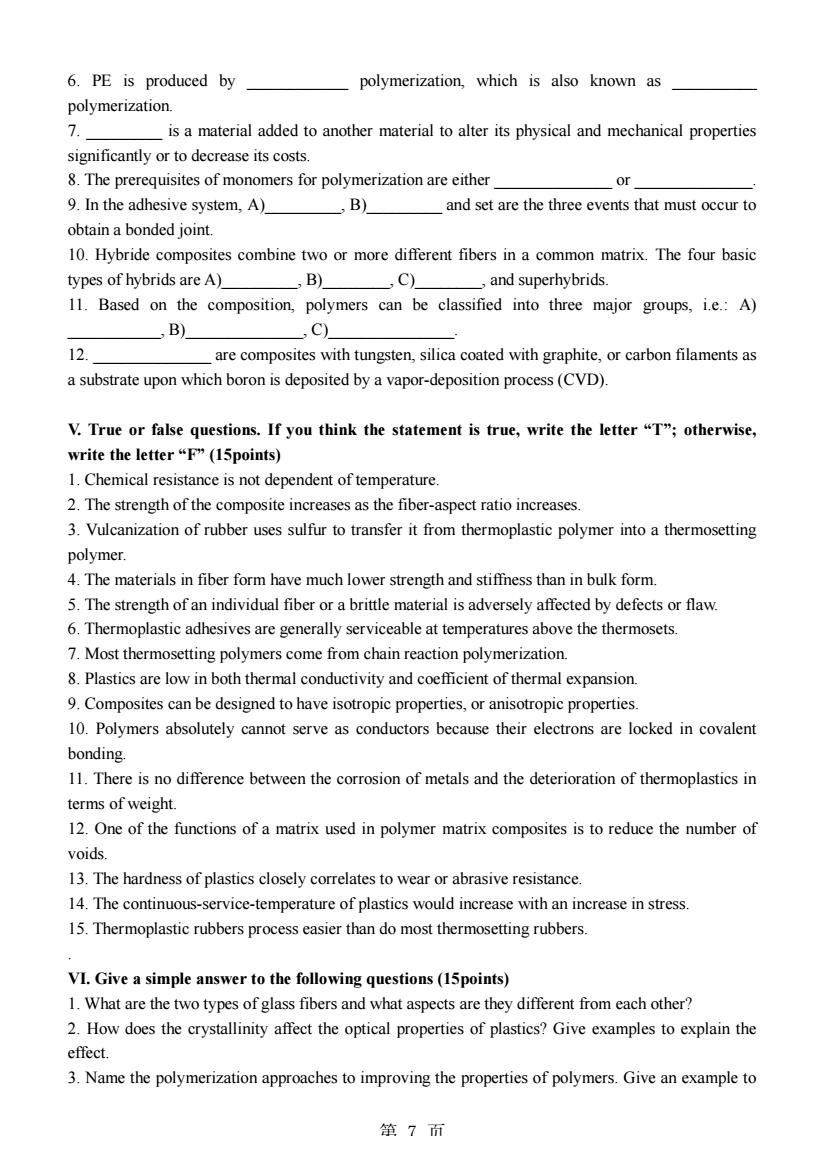
6.PE is produced by polymerization,which is also known as polymerization. 7. is a material added to another material to alter its physical and mechanical properties significantly or to decrease its costs. 8.The prerequisites of monomers for polymerization are either or 9.In the adhesive system,A) ,B) and set are the three events that must occur to obtain a bonded joint 10.Hybride composites combine two or more different fibers in a common matrix.The four basic types of hybrids areA】 ,B) C) and superhybrids. 11.Based on the composition,polymers can be classified into three major groups,i.e.:A) ,B) C 12. are composites with tungsten,silica coated with graphite,or carbon filaments as a substrate upon which boron is deposited by a vapor-deposition process(CVD). V.True or false questions.If you think the statement is true,write the letter "T";otherwise, write the letter“F”(l5 points) 1.Chemical resistance is not dependent of temperature. 2.The strength of the composite increases as the fiber-aspect ratio increases 3.Vulcanization of rubber uses sulfur to transfer it from thermoplastic polymer into a thermosetting polymer. 4.The materials in fiber form have much lower strength and stiffness than in bulk form 5.The strength of an individual fiber or a brittle material is adversely affected by defects or flav 6.Thermoplastic adhesives are generally serviceable at temperatures above the thermosets. 7.Most thermosetting polymers come from chain reaction polymerization 8.Plastics are low in both thermal conductivity and coefficient of thermal expansion. 9.Composites can be designed to have isotropic properties,or anisotropic properties 10.Polymers absolutely cannot serve as conductors because their electrons are locked in covalent bonding 11.There is no difference between the corrosion of metals and the deterioration of thermoplastics in terms of weight. 12.One of the functions of a matrix used in polymer matrix composites is to reduce the number of voids. 13.The hardness of plastics closely correlates to wear or abrasive resistance. 14.The continuous-service-temperature of plastics would increase with an increase in stress 15.Thermoplastic rubbers process easier than do most thermosetting rubbers. VI.Give a simple answer to the following q estions(15points) 1.What are the two types of glass fibers and what aspects are they different from each other? 2.How does the crystallinity affect the optical properties of plastics?Give examples to explain the effect. 3.Name the polymerization approaches to improving the properties of polymers.Give an example to 第7而
第 7 页 6. PE is produced by ____________ polymerization, which is also known as __________ polymerization. 7. _________ is a material added to another material to alter its physical and mechanical properties significantly or to decrease its costs. 8. The prerequisites of monomers for polymerization are either ______________ or ______________. 9. In the adhesive system, A)_________, B)_________ and set are the three events that must occur to obtain a bonded joint. 10. Hybride composites combine two or more different fibers in a common matrix. The four basic types of hybrids are A)_________, B)________, C)________, and superhybrids. 11. Based on the composition, polymers can be classified into three major groups, i.e.: A) ___________, B)______________, C)_______________. 12. ______________ are composites with tungsten, silica coated with graphite, or carbon filaments as a substrate upon which boron is deposited by a vapor-deposition process (CVD). V. True or false questions. If you think the statement is true, write the letter “T”; otherwise, write the letter “F” (15points) 1. Chemical resistance is not dependent of temperature. 2. The strength of the composite increases as the fiber-aspect ratio increases. 3. Vulcanization of rubber uses sulfur to transfer it from thermoplastic polymer into a thermosetting polymer. 4. The materials in fiber form have much lower strength and stiffness than in bulk form. 5. The strength of an individual fiber or a brittle material is adversely affected by defects or flaw. 6. Thermoplastic adhesives are generally serviceable at temperatures above the thermosets. 7. Most thermosetting polymers come from chain reaction polymerization. 8. Plastics are low in both thermal conductivity and coefficient of thermal expansion. 9. Composites can be designed to have isotropic properties, or anisotropic properties. 10. Polymers absolutely cannot serve as conductors because their electrons are locked in covalent bonding. 11. There is no difference between the corrosion of metals and the deterioration of thermoplastics in terms of weight. 12. One of the functions of a matrix used in polymer matrix composites is to reduce the number of voids. 13. The hardness of plastics closely correlates to wear or abrasive resistance. 14. The continuous-service-temperature of plastics would increase with an increase in stress. 15. Thermoplastic rubbers process easier than do most thermosetting rubbers. . VI. Give a simple answer to the following questions (15points) 1. What are the two types of glass fibers and what aspects are they different from each other? 2. How does the crystallinity affect the optical properties of plastics? Give examples to explain the effect. 3. Name the polymerization approaches to improving the properties of polymers. Give an example to

explain how the properties of polymers are improved by using this approach 4.Describe three methods in which adhesives develop their cured attraction between the substrate and the adherent. 5.What are the three major differences between carbon and graphite fibers? VII Complex questions.(10points) 1.What is a fiber-reinforced composite primary composed of?Use a schematic drawing to indicate the structure ofa fber-reinforced composite and their corresponding interfaces and interphase. 2.Discuss the effect of crystallinity on the toughness,strength and density of polymers and exemplify an approach to improving the crystallinity of polymers? 3.Figure I is the graphical plot of the tensile modulus of a unidirectional composite material loaded under isostrain and isostress conditions as a function of volume fraction of reinforcing fiber.Indicate which curve(A or B)is for isotrain condition?For a given volume fraction of fiber in a composite, which condition is more ininreasing the modulus?If the tensile modulus of the fiber and matrix is known,how can we calculate the tensile modulus of the composite under isostrain condition? A 06 Vea瑞 VIIL.Supplementary questions for extra points added to the total score(20pts). 1.Why is natural rubber used in automobile tires?Why are synthetic rubbers also used? 2.Give examples to explain how the properties of polymers are influenced by the structureor processing methods of polymers. 3.Discuss the factors influencing the properties of fiber-reinforced composites. 4.Define the term of"wind anglefor filament winding.How do the hoop tensile strength and axial tensile strength change with wind angle? 第8而
第 8 页 explain how the properties of polymers are improved by using this approach. 4. Describe three methods in which adhesives develop their cured attraction between the substrate and the adherent. 5. What are the three major differences between carbon and graphite fibers? VII. Complex questions. (10points) 1. What is a fiber-reinforced composite primary composed of? Use a schematic drawing to indicate the structure of a fiber-reinforced composite and their corresponding interfaces and interphase. 2. Discuss the effect of crystallinity on the toughness, strength and density of polymers and exemplify an approach to improving the crystallinity of polymers? 3. Figure 1 is the graphical plot of the tensile modulus of a unidirectional composite material loaded under isostrain and isostress conditions as a function of volume fraction of reinforcing fiber. Indicate which curve (A or B) is for isotrain condition? For a given volume fraction of fiber in a composite, which condition is more efficient in increasing the modulus? If the tensile modulus of the fiber and matrix is known, how can we calculate the tensile modulus of the composite under isostrain condition? VIII. Supplementary questions for extra points added to the total score (20pts). 1. Why is natural rubber used in automobile tires? Why are synthetic rubbers also used? 2. Give examples to explain how the properties of polymers are influenced by the structure or processing methods of polymers. 3. Discuss the factors influencing the properties of fiber-reinforced composites. 4. Define the term of “wind angle” for filament winding. How do the hoop tensile strength and axial tensile strength change with wind angle?